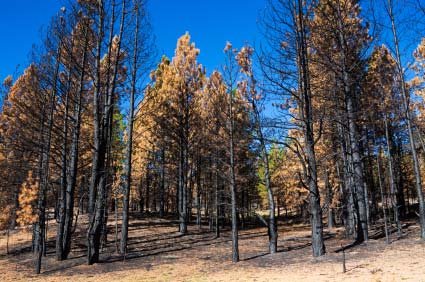Deforestation at Home
Reusable Shipping Crates

When people start to talk about logging or deforestation, their mind will usually point toward an image of the world’s rainforests being devastated. Not many people consider what toll logging or developing forest lands takes here in the United States. As far as the danger of losing our forests here in America, it is almost the opposite of what the rest of the world faces. As of 2011 the world loses about 8.5 million hectares of tropical rainforests each year. However, the United States has experienced a 39% increase of standing timber in the last 5 decades. Forests in the United States aren’t threatened by deforestation from logging or land development; instead many are overcrowded and neglected.
As a native to Colorado, I can recall in my childhood driving up into the mountains and enjoying the sight of green pine trees as far as I could see. But on my most recent trip, I was bothered to find that vast stretches of the trees were dead. In a process referred to as “Beetle Kill” pine beetles infest and kill trees at an alarming rate, usually after a fire or from trees overcrowding. In my research I found that in Colorado 70% of the 1,500,000 acres of Lodgepole pine trees have already been destroyed, and it is estimated that the current beetle kill will leave behind a deforested area the size of Rhode Island. This beetle kill outbreak is likely a result of the 1997 “blow down” in the Routt National forest which covered an area of 13,000 acres. So called environmentalist prevented the area from being logged and replanted claiming that new species would thrive in the environment. The dense area of dying trees caused a chain reaction that resulted in catastrophic beetle kill followed by wildfires; what was once a healthy national forest is now ranked in the top “15 most endangered places in America”. It should be clear to humans that for as long as we are present on the earth, we also have a responsibility to care for it. However, caring for our forests does not mean keeping away from them altogether. If we want healthy forests, we must take an active part in nurturing them.
Lumber is a great renewable resource; after all, it does grow on trees. Using materials such as plastic or Styrofoam in place of lumber is harmful to the environment, since these materials can take thousands of years to decompose. The best way to care for our forests here in the United States is to responsibly manage and harvest lumber as a renewable resource. Sustainably Managed Forests harvest lumber in a way that keeps ecosystems intact, and help forests grow healthier as they replace the harvested trees with younger, faster growing, healthier trees.
Since Sustainably Managed Forests harvest lumber, they also thin out areas of forest which are overcrowding and prevent outbreaks of disease or parasites such as beetles. The best way to make sure that our forests are being cared for and managed properly, is to only use wood products that are supplied from Sustainably Managed Forests. This benefits the market for Managed Forests, and increases the care our forests receive. In addition, any pursuit of eco-friendly businesses practices, such as using reusable shipping crates, can help toward the greater good of taking care of our planet.





By Charge a Deposit to Go Green »
By Reusable Shipping Crates | Deforestation at Home
By Reusable Shipping Crates | Deforestation at Home